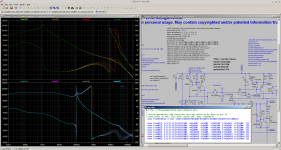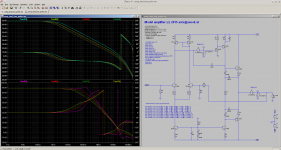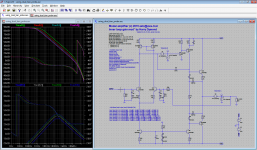4way active speaker would require a 4 channel amplifier, or two 2channel amplifiers, or four monoblocks located at the speaker.
Two 2way active speakers require a 2channel amplifier, or two monoblocks located at each speaker.
A 2.1 system does not require a 3channel amplifier, similarly a 5.1 system does not require a 6channel amplifier.
The amplifiers should be at the speakers which are distributed around the listener/s.
Two 2way active speakers require a 2channel amplifier, or two monoblocks located at each speaker.
A 2.1 system does not require a 3channel amplifier, similarly a 5.1 system does not require a 6channel amplifier.
The amplifiers should be at the speakers which are distributed around the listener/s.
Currently I'm a proud owner of a 3way transmission line speaker system in a slate cabinet using Scanspeak and ATC drivers.
The mid and high speaker have a reduced to the minimum parts passive crossover, the bass speaker has the LC combination removed.
=> need a LR24 active crossover and a 2 channel amplifier to drive one speaker.
The future plan is to remove the already reduced passive crossover for the mid/high speakers and to drive them directly with separate amplifiers.
=> need LR24 crossovers and a 3 channel amplifier to drive one speaker.
The mid and high speaker have a reduced to the minimum parts passive crossover, the bass speaker has the LC combination removed.
=> need a LR24 active crossover and a 2 channel amplifier to drive one speaker.
The future plan is to remove the already reduced passive crossover for the mid/high speakers and to drive them directly with separate amplifiers.
=> need LR24 crossovers and a 3 channel amplifier to drive one speaker.
One 2 channel and a mono block for one 3way speaker, or three monoblocks for one speaker.
Certainly not a 6channel with long speaker cables.

A 3 channel amplifier with analog active crossovers included in a "big tower" format to keep the power supply far away from the sensitive electronic parts.
Balanced inputs and an option to add digital inputs and replace analog crossovers with dsp.
Hi Tony and others,
Been reading this thread with great interest. I would like to offer a few ideas.
1) use a state variable filter, low/high pass functions. They are so flexible, esp if you are prototyping a system.
2) In the high end amps(tweeter) you can probably share a power supply but on the low end as you have found out, separate transformers or have separate secondary winding.
3) Do you or anyone else want to take over my pre-amp design (never completed, but layout done and mechanical partially done). It has analog and digital inputs, you know the same ole comps Cirrus cs8416, TI SRC4192, TI PCM7194. It uses PGA2320/PGA4311, in the original design, but I would suggest to change the design to use cs3318 now. A few other threads have debugged this chip now and offer designs.
I have the mcu stuff going in my portable radio media player unit, including IR remote, tuner using Si4735D50.
After all the portable was to be my test bed for the pre-amp, but I found I do not even need the pre-amp as the portable serves my requirements.
If you do not like vca approach, Bourns has some new motorized pots available.
You must realize that the control is a very important part of the design!! Who wants to get out of the chair every time to adjust the volume control? My knees ache, I am getting old!!
I am open to sharing this pre-amp design with the community. The more that we can collaborate, the better and faster things get done. One problem, is getting the feature set nailed down early, changes during the design phase just slow down the process. I would like to think of it as a public forum option.
Personally I think the way to go these days (if you want to sell stereos to the masses) is class "D" using TI stuff. Multiple amps/speaker combinations with a sub. I am fine with a TPA3100D2. Next design, I will use the newer TPA3116. Give it a listen first before you pass judgement!! Ever systems has its own character. With the DSP approach, you can go I2S/pcm all the way to the speakers. So many options these days. I think you have to factor in your music source, as too what hardware you design with.
All I listen too these days is my portable radio tuned to a local station CFGI, it is commercial free music. They play fantastic tunes, yes no xmas music , the ladies have that going up stairs
, the ladies have that going up stairs 
Lots of digital in my portable, Si4735D50, MAX9729(went obsolete), Rohm BU9458, PCM2902B,TPA3100D2.
What makes the system sound great is the new Morel MDT32S tweeters in the old 2-way Altec Lansing model three boxes with a upgraded xover, of course. A $10 find at a garage sale. I have a new respect for a 2-way system.
Have fun with your projects folks
Cheers
Rick
Been reading this thread with great interest. I would like to offer a few ideas.
1) use a state variable filter, low/high pass functions. They are so flexible, esp if you are prototyping a system.
2) In the high end amps(tweeter) you can probably share a power supply but on the low end as you have found out, separate transformers or have separate secondary winding.
3) Do you or anyone else want to take over my pre-amp design (never completed, but layout done and mechanical partially done). It has analog and digital inputs, you know the same ole comps Cirrus cs8416, TI SRC4192, TI PCM7194. It uses PGA2320/PGA4311, in the original design, but I would suggest to change the design to use cs3318 now. A few other threads have debugged this chip now and offer designs.
I have the mcu stuff going in my portable radio media player unit, including IR remote, tuner using Si4735D50.
After all the portable was to be my test bed for the pre-amp, but I found I do not even need the pre-amp as the portable serves my requirements.
If you do not like vca approach, Bourns has some new motorized pots available.
You must realize that the control is a very important part of the design!! Who wants to get out of the chair every time to adjust the volume control? My knees ache, I am getting old!!
I am open to sharing this pre-amp design with the community. The more that we can collaborate, the better and faster things get done. One problem, is getting the feature set nailed down early, changes during the design phase just slow down the process. I would like to think of it as a public forum option.
Personally I think the way to go these days (if you want to sell stereos to the masses) is class "D" using TI stuff. Multiple amps/speaker combinations with a sub. I am fine with a TPA3100D2. Next design, I will use the newer TPA3116. Give it a listen first before you pass judgement!! Ever systems has its own character. With the DSP approach, you can go I2S/pcm all the way to the speakers. So many options these days. I think you have to factor in your music source, as too what hardware you design with.
All I listen too these days is my portable radio tuned to a local station CFGI, it is commercial free music. They play fantastic tunes, yes no xmas music
Lots of digital in my portable, Si4735D50, MAX9729(went obsolete), Rohm BU9458, PCM2902B,TPA3100D2.
What makes the system sound great is the new Morel MDT32S tweeters in the old 2-way Altec Lansing model three boxes with a upgraded xover, of course. A $10 find at a garage sale. I have a new respect for a 2-way system.
Have fun with your projects folks
Cheers
Rick
Last edited:
Playing with LTSpice: Dual Tian probe and parameter stepping
To get rid of manually running multiple tian probe steppings I have had success using the "table" parameter.
There are two Tian probes:
Maybe someone needs this too to speed up development ...
Thanks goes to Dave Zan showing me the dual Tian ...
BR, Toni
To get rid of manually running multiple tian probe steppings I have had success using the "table" parameter.
There are two Tian probes:
- one after output using Vi/Ii/x which will be displayed using TianAn() functions
- one be4 VAS input using Vj/Ij/y which will be displayed using TianBn() functions
Maybe someone needs this too to speed up development ...
Thanks goes to Dave Zan showing me the dual Tian ...
BR, Toni
Attachments
Hi Toni, have you been using the amp you built?
Are you still pleased with it.
And are you happy with the Zener arrangement in your VAS (TIS).
Have you encountered any problems with the circuit for the time you been using it.
Sorry for all the questions, but this is a great thread and just wanting to follow up on the build.
lol I look at those graphs in the post above and wish I could interpret them
Are you still pleased with it.
And are you happy with the Zener arrangement in your VAS (TIS).
Have you encountered any problems with the circuit for the time you been using it.
Sorry for all the questions, but this is a great thread and just wanting to follow up on the build.
lol I look at those graphs in the post above and wish I could interpret them
Hi Toni, have you been using the amp you built?
Are you still pleased with it.
And are you happy with the Zener arrangement in your VAS (TIS).
Have you encountered any problems with the circuit for the time you been using it.
Sorry for all the questions, but this is a great thread and just wanting to follow up on the build.
...
Dear Vostro,
Since months "SA2014" aka "2StageEF" is in usage several hours a day and IMHO the best amplifier I have ever build. The sound is clear, exactly, dynamic, 3D - in other words awsome.
Wish you could hear the bass-power too ...
Bias is ultrastable from cold to hot.
VAS/Zener protection - absolutely no problems.
Since 2011 (rebirth of my hobby) I have build several other amplifiers like:
- 2 channel Aleph-X
- 4 channel LME49830 using 3x IRFP240, 3XIRFP9240 per module
- 4 channel LM3886 Gainclone bridged
- 2 channel SA2014 prototype
- 4 channel Class-D TDA8950j bridged (now obsolete and replaced by
- 4 channel Class-D "SystemD LiteAmp" from ChocoHolic
...
lol I look at those graphs in the post above and wish I could interpret them
Before I started this thread I have had also absolutely no idea for what these graphs are good for ...
Thanks goes to the forum members and all the good literature especially provided by Bob Cordell and Douglas Self that today I am (partially) able to interpret those graphs!
BR, Toni
...the "table" parameter...There are two Tian probes:
Hi Toni.
I am happy to see you like the dual Tian probe.
Your implementation is a little different, my version is very simple but your version may be easier to enhance for a Middlebrook GFT probe.
Could you post the ASC so I can see the details? The part on the screen shot is not quite what I expect.
Best wishes
DAvid
Last edited:
David, I'd very much like to try your dual Tian probe too.I am happy to see you like the dual Tian probe.
Your implementation is a little different, my version is very simple but your version may be easier to enhance for a Middlebrook GFT probe.
Could you post the ASC so I can see the details? The part on the screen shot is not quite what I expect.
Have you got a simple working example you could post?
And of course, I'd like to see Toni's version too.
David, I'd very much like to try your dual Tian probe too...
Happy to help.
Link >Here< to post of Paul's that has a copy of both my balun and the dual Tian probe.
It shows pretty well how to use them both.
Some of the details are hidden in the V sources to de-clutter the circuit, "encapsulation" in software nomenclature.
Best wishes
David
Last edited:
Playing with LTSpice: Dual Tian probe and parameter stepping
Attached a simplified "table" Version.
BR, Toni
Attached a simplified "table" Version.
BR, Toni
Attachments
Attached a simplified "table" Version.
Thanks Toni
I am away from my LTSpice machine, will look tomorrow.
Best wishes
David
Many thanks from me tooAttached a simplified "table" Version.
Attached a simplified "table" Version.
BR, Toni
I’m not sure that the Tian B probe is showing anything useful in this simplified example.
Me too.I’m not sure that the Tian B probe is showing anything useful in this simplified example.
I only want to show how it could be possible in LTSpice to add 2 (or even more) Tian probes to a circuit and be able to do a parameter stepping.
BR, Toni
I’m not sure that the Tian B probe is ... useful in this simplified example.
Me too.Maybe Guru Zan can explain, if the 2nd Tian probe is correctly placed and/or makes any sense...
Hi Harry, Toni
Sorry to be a bit slow to reply, been at the beach.
Like Toni, I took it mainly as demonstration of the probe implementation.
But is of interest.
The probe position does correctly look at the inner loop.
If a nested loop has no feed-forward (and this is very close) then instability will be shown correctly in either the inner or outer loop, so can be checked in either.
It may be useful to check the inner loop for non ideal behaviour that would deteriorate stability.
For instance where is the zero around 30 to 40 MHz from?
But I think the inner loop is more important to study when there is additional complexity, like HEC or even TMC.
Then there is more potential for feed-forward and non-ideal behaviour.
So the main use of the simplified example is to provide a base-line for comparison.
And on that subject, notice the phase behaviour?
Phase leads as the gain drops.
Hmm?
Best wishes
David
Hi Harry, Toni
Sorry to be a bit slow to reply, been at the beach.
Like Toni, I took it mainly as demonstration of the probe implementation.
But is of interest.
The probe position does correctly look at the inner loop.
If a nested loop has no feed-forward (and this is very close) then instability will be shown correctly in either the inner or outer loop, so can be checked in either.
It may be useful to check the inner loop for non ideal behaviour that would deteriorate stability.
For instance where is the zero around 30 to 40 MHz from?
But I think the inner loop is more important to study when there is additional complexity, like HEC or even TMC.
Then there is more potential for feed-forward and non-ideal behaviour.
So the main use of the simplified example is to provide a base-line for comparison.
And on that subject, notice the phase behaviour?
Phase leads as the gain drops.
Hmm?
Best wishes
David
Hi David,
I am not sure you've missed it or just ignored it, but I would like to have your opinion about what I said here http://www.diyaudio.com/forums/solid-state/243481-200w-mosfet-cfa-amp-70.html#post4230628
Best wishes
Damir
The probe position does correctly look at the inner loop.
Yes, the position of the probe is correct, but it does not give the loop gain of the inner loop, if the outer loop is active. How can a feedback loop with a capacitor (of order pF) as the feedback element have almost 90 dB of gain at 1 Hz?
To observe the inner loop loop gain, you need to disable the global loop at AC (global loop DC feedback still required in order to bias the amplifier properly). This can be done by shorting the +ve and -ve inputs to ground via 1 kF capacitors. I’ve modified the .asc to do this when the TianB is active (see attached). Now, we get more realistic looking curves for the loop gain of the inner feedback loop.
Enjoy,
Harry.
I should have said before - thanks to astx for bringing the “table” keyword/syntax to my attention - this looks like it could be very handy!
Attachments
- Home
- Amplifiers
- Solid State
- 2stageEF high performance class AB power amp / 200W8R / 400W4R


